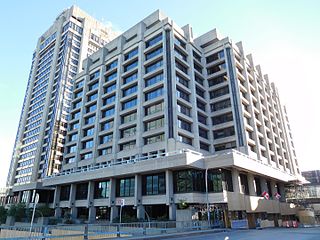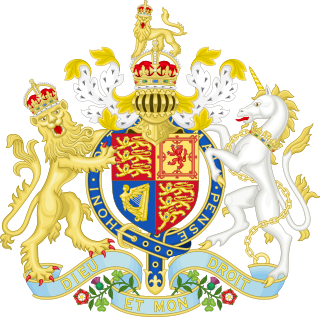
A copyright is a type of intellectual property that gives the creator of an original work, or another right holder, the exclusive and legally secured right to copy, distribute, adapt, display, and perform a creative work, usually for a limited time. The creative work may be in a literary, artistic, educational, or musical form. Copyright is intended to protect the original expression of an idea in the form of a creative work, but not the idea itself. A copyright is subject to limitations based on public interest considerations, such as the fair use doctrine in the United States.

Intellectual property (IP) is a category of property that includes intangible creations of the human intellect. There are many types of intellectual property, and some countries recognize more than others. The best-known types are patents, copyrights, trademarks, and trade secrets. The modern concept of intellectual property developed in England in the 17th and 18th centuries. The term "intellectual property" began to be used in the 19th century, though it was not until the late 20th century that intellectual property became commonplace in most of the world's legal systems.

The World Intellectual Property Organization is one of the 15 specialized agencies of the United Nations (UN). Pursuant to the 1967 Convention Establishing the World Intellectual Property Organization, WIPO was created to promote and protect intellectual property (IP) across the world by cooperating with countries as well as international organizations. It began operations on 26 April 1970 when the convention entered into force. The current Director General is Singaporean Daren Tang, former head of the Intellectual Property Office of Singapore, who began his term on 1 October 2020.

An industrial design right is an intellectual property right that protects the visual design of objects that are purely utilitarian. An industrial design consists of the creation of a shape, configuration or composition of pattern or color, or combination of pattern and color in three-dimensional form containing aesthetic value. An industrial design can be a two- or three-dimensional pattern used to produce a product, industrial commodity or handicraft.
The Paris Convention for the Protection of Industrial Property, signed in Paris, France, on 20 March 1883, was one of the first intellectual property treaties. It established a Union for the protection of industrial property. The convention is still in force in 2023. The substantive provisions of the Convention fall into three main categories: national treatment, priority right and common rules.

Industrial property is one of two subsets of intellectual property, it takes a range of forms, including patents for inventions, industrial designs, trademarks, service marks, layout-designs of integrated circuits, commercial names and designations, geographical indications and protection against unfair competition. In some cases, aspects of intellectual creation, although present, are less clearly defined. The object of industrial property consists of signs conveying information, in particular to consumers, regarding products and services offered on the market. Protection is directed against unauthorized use of such signs that could mislead consumers, and against misleading practices in general.

The Canadian Intellectual Property Office is responsible for the administration and processing of the greater part of intellectual property (IP) in Canada. CIPO's areas of activity include patents, trademarks, copyright, industrial designs and integrated circuit topographies. Structurally, CIPO functions as a special operating agency (SOA) under Innovation, Science and Economic Development Canada. CIPO is based in Gatineau, Quebec, part of the National Capital Region. CIPO’s current interim Chief Executive Officer is Konstantinos Georgaras.

In the United States, a design patent is a form of legal protection granted to the ornamental design of an article of manufacture. Design patents are a type of industrial design right. Ornamental designs of jewelry, furniture, beverage containers and computer icons are examples of objects that are covered by design patents.
Intellectual property law in Romania has developed significantly in the period since the Romanian Revolution of 1989 because of the need to enforce various regional and international treaties and agreements, such as the Agreement on Trade-Related Aspects of Intellectual Property Rights (TRIPS), the European Directives on Biotechnological Inventions, on Trademarks and Geographical Indications, and on Supplementary protection certificates, the Trademark Law Treaty, the Patent Law Treaty, and the European Union regulation on the Community Trademark, and the need to harmonize domestic patent law with the European Patent Convention (EPC) and with the European Union.
Industrial design rights in the European Union are provided at both the Union level by virtue of the Community design and at the national level under individual national laws.
The Patent and Designs Act 1911 is a law concerning intellectual property in Bangladesh. It includes several key definitions, including of ‘Attorney General’, ‘Copyright’, ‘Design’, ‘Patent’ and ‘Manufacture’.

The following outline is provided as an overview of and topical guide to intellectual property:

The Registered Designs Act 1949 is an act in the United Kingdom concerning copyright and related rights, industrial designs, patents, protection of undisclosed information. The purpose of the act was to consolidate certain enactments relating to registering designs. "The Act prescribes that where an application for the registration of a design has been abandoned or refused, information filed in pursuance of the registration shall not be open to public inspection".

Layout designs (topographies) of integrated circuits are a field in the protection of intellectual property.
The laws of Thailand are based on the civil law, but have been influenced by common law.
The Corporate Affairs and Intellectual Property Office (CAIPO) is a Barbadian governmental agency in charge of various aspects of industrial property right affairs including: patents, trademarks, and industrial designs. It is a division of the Ministry of Industry & International Business. The CAIPO office is located on Belmont Road, Saint Michael, Barbados. The country ranks as one of the top countries where the greatest number of foreign patents are legally based.

Iran is a member of the WIPO since 2001 and has acceded to several WIPO intellectual property treaties. Iran joined the Convention for the Protection of Industrial Property in 1959. In December 2003 Iran became a party to the Madrid Agreement and the Madrid Protocol for the International Registration of Marks. In 2005 Iran joined the Lisbon Agreement for the Protection of Appellations of Origin and their International Registration, which ensures the protection of geographical names associated with products. As at February 2008 Iran had yet to accede to The Hague Agreement for the Protection of Industrial Designs.
Registration of intellectual property in Ghana is key to safeguarding one's intellectual efforts from infringement. Intellectual property law of Ghana encompasses intellectual property (IP) laws in Ghana, such as laws governing copyright, patent, trademark, industrial design rights, and unfair competition. The main intellectual property laws in Ghana include the Copyright Act, 2005, the Patents Act, 2003, the Trademarks Act, 2004, the Industrial Designs Act, 2003 and the Protection Against Unfair Competition Act, 2000. These are supplemented by regulations passed by the Legislature to augment the rate of development under IP laws.
The Industrial Designs Act, 2003 is a Ghanaian act to revise the enactments on the protection of industrial designs and to provide for related matters. The Act is one of the Seven Acts that exist to protect Intellectual Property Rights in Ghana namely; Protection against Unfair Competition Act, 2000 ; Industrial Designs Act, 2003 ; Geographical Indications Act, 2003 ; Patents Act, 2003 ; Trademarks Act, 2004 ; Layout-Designs (Topographies) of Integrated Circuits Act, 2004 and Copyrights Act, 2005.

Design is a form of intellectual property right concerned with the visual appearance of articles which have commercial or industrial use. The visual form of the product is what is protected rather than the product itself. The visual features protected are the shape, configuration, pattern or ornamentation. A design infringement is where a person infringes a registered design during the period of registration. The definition of a design infringement differs in each jurisdiction but typically encompasses the purported use and make of the design, as well as if the design is imported or sold during registration. To understand if a person has infringed the monopoly of the registered design, the design is assessed under each jurisdiction's provisions. The infringement is of the visual appearance of the manufactured product rather than the function of the product, which is covered under patents. Often infringement decisions are more focused on the similarities between the two designs, rather than the differences.





